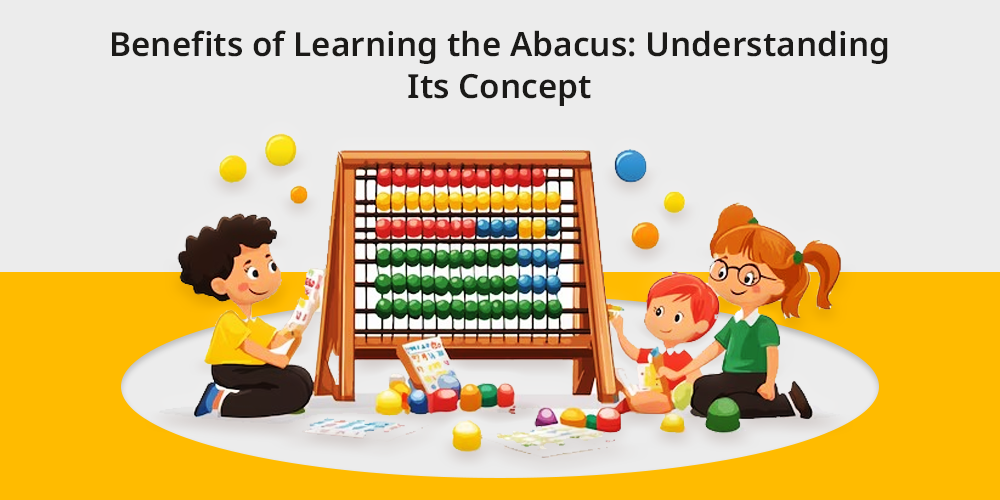
Have you ever heard of the Abacus, and do you know why it is trending in the 21st century?
The abacus is a calculating device used for computing and counting, which was developed in the 16th or 17th century. Abacus allows kids to master their numerics and calculations, which is essential for a child’s holistic development.
Through the abacus, students can calculate any Maths using division, multiplication, addition and subtraction, and they can also use some formulas.
Learning the abacus helps students to enhance their problem-solving skills and supports children’s development.
However, in modern education abacus seems to look outdated, but still learning the abacus allows students to enhance learning outcomes. Due to its various benefits, the abacus is gaining popularity and enhancing students’ interest towards it.
There are various e-learning platforms and online programs that offer students opportunities to learn the abacus.
Contents
- Understanding the Abacus
- Top 12 Benefits of Learning the Abacus
- 1. Enhance Memory
- 2. Boost Critical Thinking Skills
- 3. Develop Analytical Thinking
- 4. Promotes Creative Thinking Skills
- 5. Enhance Eye-Hand Coordination
- 6. Enhance Speed and Accuracy
- 7. Promotes Mental Health
- 8. Boost Fine Motor Skills
- 9. Enhance Problem-Solving Skills
- 10. Enhance Auditory and Visual Memory
- 11. Enhance Observation Skills
- 12. Promotes Two-Way Concentration
- Final Thoughts
Understanding the Abacus
An abacus acts as a calculating device that is used for manual counting and arithmetic operations.
The abacus originated in the 16th or 17th century during various civilisations, which was used for foundations and Mathematical principles.
In the abacus, there is a series of rods and beads in which students have to move each bead in order to perform calculations. The main objective of introducing the abacus is to make calculations easier and faster.
Learning the abacus helps in developing problem-solving skills and enhances their academic performance, as well as calculation speed.
Abacus is not limited only to kids, but any individual can learn at any age; however, it is ideal to introduce the abacus at an early age of 5 to 6 years old.
This is the best time to develop habits of mind and make calculations easy for kids.
Top 12 Benefits of Learning the Abacus
Learning the abacus is essential for understanding Mathematical principles and disciplines.
Abacus allows students to enhance their critical thinking skills and Intelligence Quotient (IQ), which also improves their calculation speed and helps in developing the brain synopsis of students.
An abacus helps in enhancing memory retention and makes calculations more effective. Here you can check the benefits of learning the abacus mentioned below.
1. Enhance Memory
Learning the abacus allows students to enhance their memory power through problem-solving techniques. Performing calculations with an abacus allows students to develop brain stimuli that enhance children’s mental health.
Solving abacus problems daily helps in enhancing memory retention and allows students to grasp concepts more easily.
Through the abacus, students can retain any information for a longer period of time, which also allows them to enhance curiosity and fosters an entrepreneurial mindset.
2. Boost Critical Thinking Skills
Abacus helps in enhancing critical thinking skills, which allows individuals to develop logical reasoning.
Abacus helps in understanding the relationship between numbers and their principles, which allows them to evaluate the numerics and apply rules to get solutions.
This method assists them to focus on the problems rather than finding alternative ways. Through this, students can develop problem-solving skills and enhance mental speed.
3. Develop Analytical Thinking
Abacus allows students to enhance their focus and accuracy, which leads to better analytical thinking.
Analytical thinking assists students in analysing problems and finding alternate solutions, which increases efficiency.
This also helps students to learn important manners and apply them in real-world scenarios. With the abacus, students can also enhance their understanding level, which aids them in achieving their long-term and short-term goals.
4. Promotes Creative Thinking Skills
Creative thinking skills are one of the most important aspects that allow students to analyse, investigate, and develop multiple solutions.
Through indulging in the abacus, students can find the solutions with creative strategies, which enhances their learning methods.
Through the abacus, students find how to relate numbers to the principles, which is also very essential for developing creative strategies.
5. Enhance Eye-Hand Coordination
Using an abacus to perform calculations allows children to enhance eye-hand coordination.
Moving beads up and down in order to perform calculations allows students to have control over their fingers and muscle memory.
This allows students to have command over their eye movement and muscle memory. Eye and hand coordination assist students in their day-to-day activities and develop fine motor skills.
6. Enhance Speed and Accuracy
Practising the abacus allows students to enhance their speed and accuracy in their calculations. Through this, they can calculate long digit numbers and perform complex calculations with speed and accuracy.
This becomes possible because the abacus uses numbers instead of symbols or phrases. Good speed and accuracy allow students to do Maths calculations accurately and fast and achieve good marks in exams.
7. Promotes Mental Health
The abacus is also known for enhancing the mental health of students through focus and memory retention. Practising the abacus allows students to develop associative memory and creative thinking skills.
This allows the brain to process information efficiently and accurately, which allows it to think out of the box.
With the help of associative thinking, children can find solutions to complex problems through which they can solve it quickly, and hence it promotes mental health.
8. Boost Fine Motor Skills
Learning the abacus allows kids to develop fine motor skills through the coordination of hands and muscle memory.
Moving beads and keeping track of numbers allows children to improve their finger grips and muscle strength, which also helps in the visualisation of numbers.
Abacus includes manual movements of beads, and regularly indulging in this activity promotes efficiency. Fine motor skills are essential for day-to-day activities through which they can engage in strength work.
9. Enhance Problem-Solving Skills
Learning the abacus helps children to analyse the perspective of different principles. This allows students to think about the problem in the first place, so they can evaluate different types of solutions.
This allows them to develop problem-solving skills through practical approaches and enhances their mental ability to take challenges as opportunities.
Abacus also helps in memory retention through better focus and concentration on a particular contexts.
10. Enhance Auditory and Visual Memory
One of the major benefits of the abacus is that it enhances auditory and visual memory among children.
Children learn how to recall numbers when they use an abacus because they can listen to the numbers, repeat them correctly and remember where they are on the abacus.
This allows students to enhance their speed and efficiency in problem solving. This method is also very effective for students who have a problem with understanding the relationship between two aspects.
11. Enhance Observation Skills
The abacus is also known for enhancing observation skills in students. Through the abacus, students learn to assess different aspects and criteria while performing calculations.
This helps them in observing and understanding different patterns in order to create efficient solutions.
Through observation skills, children develop attention to detail, which assist them to understand the relationship between two aspects and their differences.
12. Promotes Two-Way Concentration
Abacus allows students to enhance their two-way concentration, through which they can concentrate on a specific task for a longer period of time.
Abacus allows students to focus on mental concentration and look for different solutions.
Two way concentration assists kids to perform mental calculations and draw them in paper simultaneously, which enhances their mathematical capabilities faster.
Final Thoughts
There are several advantages to learning the abacus that go beyond improving your math abilities.
In addition to supporting mental health and fine motor skills, it improves memory retention, critical thinking, analytical skills and creative problem-solving abilities.
An essential tool in contemporary education, the abacus helps children develop their cognitive skills.
The abacus is still relevant in the twenty-first century despite its historical origins because it keeps students interested and encourages a deeper comprehension of mathematical concepts.
People of all ages can now benefit from learning the abacus and developing a lifelong love of mathematics thanks to the availability of numerous online learning resources.


